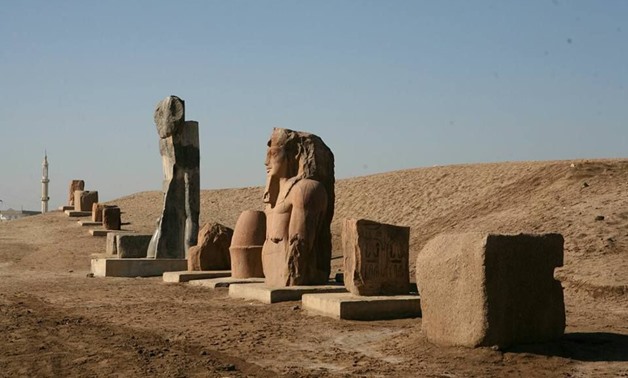
Ramses II stelae previously uncovered at San el-Hagar site - Pinterest/Tanin
CAIRO – 1 July 2020: Head of the Central Department for Engineering Affairs, Antiquities and Museum Projects Waad Abul-Ela said the sector is constructing a stone wall at San el-Hagar, where a distance of more than 1 kilometer, out of a total of 6 kilometers, has been built, as part of the development work in the region.
Abul-Ela further explained during statements made to the press that the completion of the wall will need a time-span of at least a year, in order to carry out excavation works at the bottom of the fence, so as not to construct the wall on artifacts that may be buried in the ground.
Also, Abul-Ela pointed out that the construction of the fence is carried out for the purpose of protecting the region, in cooperation with the French side and as part of the Egyptian-French project, with the aim of raising the efficiency of the site, after Europe and the foreign affairs of France agreed to finance the project.
This comes in light of the critical importance of San el-Hagar Archaeological City, where French archaeological missions have been operating for nearly 90 years.

Abul-Ela also stated that in coordination with the French Mission for Excavations in San el-Hagar, the implementation of this project has been assigned to the Ministry of Antiquities and the French Institute for Oriental Archaeology (IFAO), to benefit from the experience of the Louvre Museum and many French scientific institutes, especially the University of Montpellier and the Interdisciplinary Center for the Conservation and Restoration of Heritage (CICRP). The Fonds Khéops Fund for Archeology took part in the project, which is also supported by the French Ministry of Culture.
Furthermore, the project includes setting up an interpretation center and providing instructions for visitors, restoring the ancient antique door of Shoshenq III, restoring all the monuments on site, protecting the royal tombs from rainwater, conserving and restoring royal tombs, preparing the royal tombs to receive visitors. This is in addition to creating electronic pages that provides more information and archival pictures of the history of the discoveries, and displays monuments discovered in the royal tombs.

It is worth noting that the San al-Hagar region was the capital of ancient Egypt during the 21st and 23rd Dynasties. It was also the headquarters for the burial of the kings of these two families.
The city played an important role in political and religious life until the Arab conquest. The city simulated in its buildings the city of Thebes and was called the Thebes of the North.
Since the mid-19th century, the region has witnessed excavations at the hands of a number of foreign missions, which have been able to uncover many archaeological temples, the most important of which are the Temple of Amun, the Temple of Mut, the Temple of Horus, and the Temple of the East.


Comments
Leave a Comment